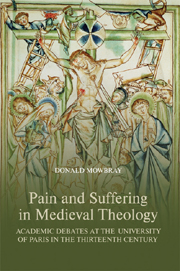 Pain and Suffering in Medieval Theology
Pain and Suffering in Medieval Theology Book contents
- Frontmatter
- Contents
- Acknowledgements
- Abbreviations
- Dedication
- Introduction
- 1 Thirteenth-Century Theological Ideas about Human Pain and Suffering and the Passion of Christ
- 2 Gendering Pain: Theological Ideas about Female and Male Suffering
- 3 Pain as a Restorative Power: Voluntary Suffering and Satisfaction for Sin
- 4 The Intellectual Development of Limbo: Pain, Children and Original Sin
- 5 Anima Separata: Masters of Theology and the Controversy surrounding the Suffering of the Separated Soul
- 6 Defining the Corporeal: Suffering in Hell according to Masters of Theology at Paris, c.1230–c.1280
- Conclusion
- Select Bibliography
- Index
5 - Anima Separata: Masters of Theology and the Controversy surrounding the Suffering of the Separated Soul
Published online by Cambridge University Press: 12 September 2012
- Frontmatter
- Contents
- Acknowledgements
- Abbreviations
- Dedication
- Introduction
- 1 Thirteenth-Century Theological Ideas about Human Pain and Suffering and the Passion of Christ
- 2 Gendering Pain: Theological Ideas about Female and Male Suffering
- 3 Pain as a Restorative Power: Voluntary Suffering and Satisfaction for Sin
- 4 The Intellectual Development of Limbo: Pain, Children and Original Sin
- 5 Anima Separata: Masters of Theology and the Controversy surrounding the Suffering of the Separated Soul
- 6 Defining the Corporeal: Suffering in Hell according to Masters of Theology at Paris, c.1230–c.1280
- Conclusion
- Select Bibliography
- Index
Summary
In previous chapters the pain experienced in and by the soul has been considered in terms of the embodied soul, that is, the soul as part of the human composite. However, masters of theology followed the widely held belief that when the body died, soul and body were separated until resurrection. The suffering of the resurrected body is the focus of the following chapter. This chapter examines the period between death and resurrection, during which the separated souls of the damned reached hell and experienced its torments. As has been seen in earlier chapters, sense perception and the reception of pain and suffering depended upon activity within the human composite. Masters developed a distinct vocabulary and set of ideas to understand and explain the action of pain on the human body and soul. Therefore, the soul without the body presented a different set of challenges to this system. In the first section of this chapter, therefore, theories about the separated soul and the questions the masters asked about its nature are considered in order to ascertain how they understood and described the soul when it was separated from the body.
One issue which seems to have been high on the agendas of the masters was how the separated souls of the damned in hell could suffer the torment of corporeal fire. This was very important for two reasons. First, the theory of the composite did not permit easy discussion of a soul without its co-element in the composite: the body.
- Type
- Chapter
- Information
- Pain and Suffering in Medieval TheologyAcademic Debates at the University of Paris in the Thirteenth Century, pp. 104 - 130Publisher: Boydell & BrewerPrint publication year: 2009
